Accelerated Construction
slide 1: Accelerated Construction
Quarterly Work Zone Webinar
Seema Javeri
Office of Operations
FHWA

Download the Printable Version [PDF,
1 MB]
You may need the Adobe® Reader® to view this PDF.
slide 2: Agenda
- History
- Accelerated Construction Options
- Benefits
- Success Stories
- Questions
slide 3: History
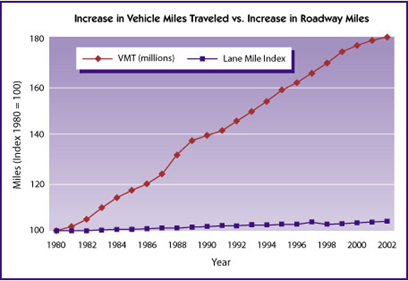
slide notes:
National Perspective
A typical highway project can take from 10 to 15 years to complete.
This time duration has real consequences for the public.
Agencies are seeking ways to accelerate project delivery to deliver projects to the public faster.
Work zones account for nearly 24 percent of non-recurring congestion, or 482 million vehicle hours of delay.
Work zones also have adverse impacts on traveler and worker safety.
Between 1982 and 2002, route miles of highway increased 3.0 percent while vehicle miles of travel grew by 79 percent.
Rush "hour" is no longer an hour. Between 1982 and 2002, it increased from 3-4 hours to 6-7 hours.
Source: http://ops.fhwa.dot.gov/aboutus/one_pagers/wz.htmslide 4: History
- Accelerated Construction Technology Transfer started in 1999.
- Construction practices that speed project delivery.
- Management practices that minimize the duration of work zone occupation.
slide notes:
You may have heard the phrase "Get in, Stay in (and get it done right), Get out, and Stay out".
As agencies are looking to manage traffic in work zones and develop TMPs, accelerated construction is becoming more popular as efforts are taken to minimize the impacts of construction to the roadway users.
The Accelerated Construction program focused on achieving this objective. Using national transportation leaders to identify strategic planning goals, innovative techniques, and newer technologies, to address the construction safety, time and traffic congestion concerns of today's large, complex multi-phase projects.
By advancing 21st Century Solutions – we can improve safety, reduce congestion, and keep America moving and competitive.
This portion of the webinar will focus on applications for accelerated construction, how much is it being done (both bridge and roadway), who is using it, what are the benefits (especially to work zone safety and mobility), why consider it, etc.
slide 5: Accelerating Construction Options

|
|
slide notes:
None.
slide 6: 3D Modeling
- Can increase some construction operations by up to 50%
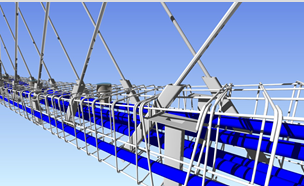
slide notes:
3D Modeling for Construction Means and Methods: 3D modeling technology has been widely used by contractors on non-highway projects, and the potential for highway applications is just now being realized.
An overall benefit of the technology is an increase in productivity and efficiency of construction operations.
As an example, GPS-enabled construction equipment, when combined with the 3D terrain model can run all day and night while achieving accurate grades on the first pass.
These technologies together can increase productivity by up to 50 percent for some operations.
slide 7: States Exploring 3D Engineered Models for Construction

slide notes:
Goal is that By December 31, 2014, FHWA Division Offices will partner with State DOT's and/or Local Public Agencies and Federal Lands Highway Divisions will partner with Federal Agencies and/or Tribal Nations to obtain the following two independent goals:
Create and apply 3D Engineered Models for Construction, consisting of a digital model representing features within the roadway prism, to construct 50 projects nationwide, and;
Nationally, have 25 or more transportation agencies use 3D Engineered Models for Construction.
The goals for implementation are based on a more widespread use of 3D models by owner-agencies during design or by contractors who develop a 3D model. Given the varying levels of use of 3D engineered models for construction, the first goal advances use on projects and the second goal is focused on agency transition from 2D plan sets to 3D digital models.
Implementation Criteria: A transportation facility owner is considered to have implemented 3D Engineered Models for Construction if models are used on a minimum of two or more projects.
slide 8: 4D Modeling – Scheduling
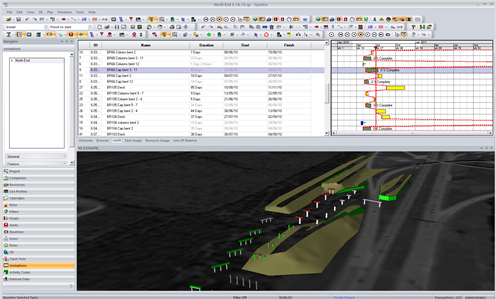
slide notes:
A 4D model looks just like a 3D model, but adds a time equation into the project management process. It contains even more information about installation rates, productivity rates, crew sizes, and costs.
4-D Scheduling is simply linking your Primavera P6 Schedule to your 3D design model. A program called Synchro can be used.
Synchro is a program that is very easy to use and provides a great tool for analyzing your schedule as well as explaining it to other including non-technical 3rd Parties such as cities, counties, local jurisdiction and the general public. It allows you to either hit "play" which will show the project develop as the timeline moves through the schedule or select any point in time where you can then visually see what the project will look like at that point.
slide 9: 5D Modeling Cost Estimating
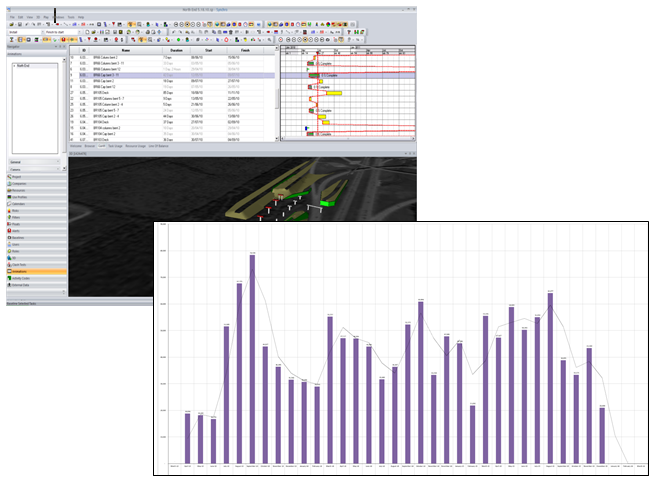
slide notes:
And a 5D model looks just like a 3D model, but it includes cost.
The model enables an accurate quantity survey of materials and components, with the quantities linked directly to a cost database.
Put this all together and you get the iterative effect of 3D-4D-5D CIM.
slide 10: Accelerated Bridge Construction
- Prefabricated Bridge Elements and Systems
- Slide-In Bridge Construction
- Geosynthetic Reinforced Soil
slide notes:
Accelerated Bridge Construction: Accelerated Bridge Construction (ABC) technologies allow transportation agencies to replace bridges faster – only delaying traffic during construction for hours rather than months or years
slide 11: Prefabricated Bridge elements and systems (PBES)
- Offers a wide range of advantages, including savings in cost and time, enhanced safety for both construction workers and the driving public, increased quality, and potential for cost savings.
- 2500 replacement bridges
- 39 states and 3 FLH Divisions have used PBES in at least one bridge project
slide notes:
Prefabricated Bridge Elements and Systems (PBES), where entire structures or their components are manufactured and assembled off site and moved into place in a matter of hours;
slide 12: Slide in Bridge
- A bridge is built adjacent to an old structure and slid into place once the old facility is removed.
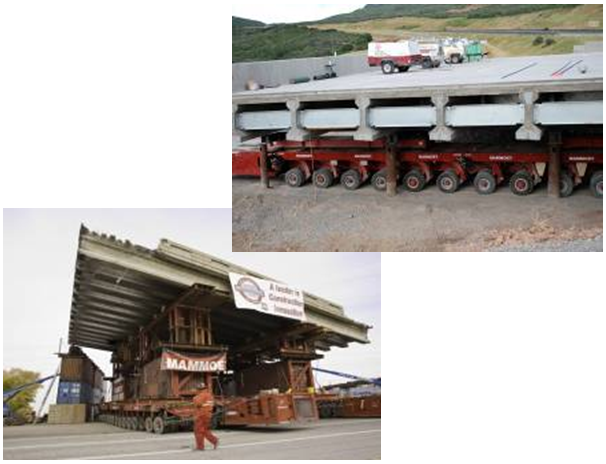
slide notes:
Slide-In Bridge Construction, a construction technique for deploying PBES where a bridge is built adjacent to an old structure and slid into place once the old facility is removed.
slide 13: Geosynthetic Reinforced Soil – Integrated Bridge System (GRS-IBS)
|
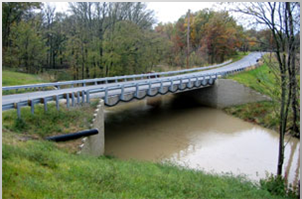 |
slide notes:
Geosynthetic Reinforced Soil – Integrated Bridge System (GRS-IBS), a concept for using closely spaced geosynthetic reinforcement and granular soils as a composite material to build enhanced abutment and approach embankments for bridges.
The technology offers unique advantages in the construction of small bridges, including:
- Reduced construction time and cost, with costs reduced 25 to 60 percent from conventional construction methods.
- Easy to build with common equipment and materials; easy to maintain because of fewer parts.
- Flexible design that's easily modified in the field for unforeseen site conditions, including utilities, obstructions, existing structures, variable soil conditions, and weather.
slide 14: Construction Manager/General Contractor (CM/GC)
- Owner hires a contractor to provide feedback during the design phase, before the start of construction they may stay on for construction.
- 20 projects advanced over the past 3 years; 25 planned over the next 2 years
- 18 States have laws/policies allowing CM/GC contracting; 20 projects
slide notes:
Another method used to accelerate project delivery is the Construction Manager/General Contractor (CMGC) process.
In this process, the project owner hires a contractor to provide feedback during the design phase, before the start of construction.
The CMGC process is broken down into two contract phases.
The first contract phase, the design phase, allows the contractor to work with the designer and the project owner to identify risks, provide costs projections and refine the project schedule.
Once the design phase is complete, the contractor and project owner negotiate on the price for the construction contract. If all parties are in agreement with costs then the second contract phase, the construction phase, is kicked off and construction begins.
There are advantages to using the CMGC process. The contractor acts as the consultant in the design process and can offer new innovations, best practices and reduced costs and schedule risks as a result of the contractor's years of proven experience doing the actual work.
This process also allows the project owner to employ new innovations, assist in the design process, and make informed decisions regarding cost and schedule.
- With CM/GC, State DOTs have greater control over price, schedule, and scope in comparison with DB.
- During the CM/GC design process, the construction manager must provide price, schedule, and constructability input, analyses, and recommendations.
- CM/GC offers more accurate price information, since real-time pricing is inherent to the method compared with traditional owner developed estimating processes.
- More accurate and stable price information creates better budgeting and financing opportunities, allowing State DOTs to improve their transportation planning process.
- Utah is the leader in CM/GC contracting with more than 20 highway construction projects that have used this method.
slide 15: Design Build
- 25 DOTs and 1 FLH division have each administered more than 3 DB projects in the past two years
- Alternative Technical Concept
- 29 States have expanded their DB Statutory authority
slide notes:
There are three phases in conventional highway construction projects known as D-B-B. The process begins with the design of a facility, followed by a request for contractors to bid on constructing the facility, and generally the lowest bid wins the job, and finally, the construction phase.
The process can lead to lengthy project delays because it must be completed in sequential order and delays can occur from the lack of communication or sharing of expertise between the designer and contractor.
Design Build (DB) allows the process to be accelerated dramatically. In the DB process, a State DOT identifies what it wants constructed, accepts bids and selects a contractor to assume the risk and responsibility for both the design and construction phases. With DB, agencies generally have the option of selecting a contractor based on a best-value basis; allowing DOTs to consider other factors beyond lowest price. The DB-er also may have the foresight or experienced team to develop different MOT phases to minimize the impact to the traveling public.
Alternative Technical Concepts: An Alternative Technical Concept (ATC) is a suggested change by the contractor to the contracting agency's basic configuration design, scope, or construction criteria. The proposed concept provides a solution that is equal to or better than the requirements in the Request for Proposal document. If a proposer's concept is acceptable to the contracting agency, the proposer may incorporate that concept in its technical and price submittal. ATCs provide competing teams with the opportunity to suggest innovative, cost-effective solutions.
The photo on this page is where I have seen first hand where a contractor has come up with a design that significantly cuts the cost and duration of the project by proposing an alternative design concept. It was a project where as the owner we had proposed a tunnel for stacked ramps in the RFP due to tight right of way. The contractor was able to come up with a side by side design where the tunnel was eliminated. This reduced construction costs significantly as well as long term maintenance costs. This project was completed 8 months ahead of schedule and the traveling public could feel traffic relief over 1 year early due to opening of a certain section of the roadway at one of the busiest interchanges in the Seattle metro area.
slide 16: Intelligent Compaction
|
 |
slide notes:
Intelligent Compaction;
Compaction is one of the most important processes in roadway construction. It is needed to achieve high quality and uniformity of pavement materials, which in turn enhances long-lasting performance.
Current processes using conventional compaction machines may result in inadequate and/or non-uniform material densities, which can help bring premature failure to the pavements.
Intelligent Compaction (IC) delivers a modern approach to compaction with the use of special vibratory rollers equipped with accelerometers, an integrated measurement system, a map based Global Positioning System– (GPS–), onboard display and computer reporting system. By integrating all components the use of IC rollers can accelerate projects delivery as well as improve quality. IC rollers also collect enough data to display continuous records of the number of roller passes, material stiffness measurement values, and precise location of the roller. The overall result is a more consistent pavement and projects can be constructed quickly if there is less re work needed.
slide 17: Prefabricated Concrete Panels
|
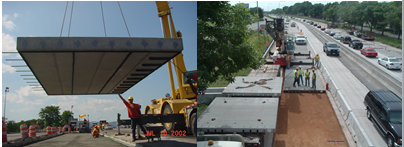 |
slide notes:
Bottom picture is placement of jointed precast concrete panels on Trunk Highway 62 in Minnesota.
slide 18: Accelerated Construction Benefits
- Maintenance of Traffic
- Work Zone Safety
- Reduced User Delays
- Life-Cycle Cost
- Sustainability
- Economic Impacts
- Environmental Impacts
- Social Impacts
slide notes:
- Reduce traffic impacts
- Improve safety to workers and public -Safer, since construction workers are not working near active traffic for days on end with traditional approaches.
- Saves traveling public time in traffic delays and road closures
- Reduced construction season and reduced construction time
- Costs savings
- Improve quality of constructed product
- The accelerated project times can potentially reduce project costs.
- Sustainability
- Reduced economic and business impacts
- Reduced environmental impacts since components may be fabricated off site, and because bridges or their components are manufactured off site, in controlled environments, quality is increased and bridges last longer.
slide 19: Success!
|
The Christopher S. Bond Bridge - Missouri Department of Transportation (MoDOT)
|
 |
slide notes:
Design Build and Prefabricated Bridge Elements and Systems, the Missouri Department of Transportation (MoDOT) opened a new bridge over the Missouri River, a full 9 months ahead of schedule.
The award-winning structure, called the Christopher S. Bond Bridge in honor of the senator, utilized innovative design and construction methods such as design-build contracting and prefabricated bridge elements and systems. saved MoDOT up to $89 million and more than 5 years of construction related traffic congestion.
slide 20: Questions?
slide notes:
For specific guidance for utilizing one of these methods please contact your state FHWA Division office.